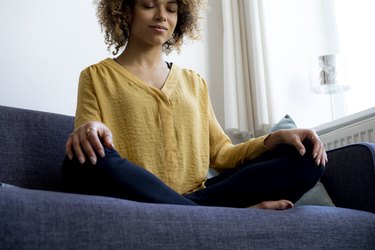
Sitting, standing and moving from a sit to a stand seem almost involuntary, but your body's muscles are actually working hard to make these actions happen. More than 600 muscles are attached to your skeleton, and many of them are involved in these actions you do multiple times per day.
The chief muscles used to sit and stand are your leg and hip muscles (especially quadriceps, hamstrings and glutes), your abdominals and other core muscles, and often, some muscles in your upper body too.
Video of the Day
Video of the Day
Leg Muscles
The largest muscles of your upper legs are your quadriceps and hamstrings. The quadriceps are the four muscles in the front of your thigh, whereas your hamstrings are the three muscles situated in the back of your thigh.
In addition to these large muscles, your gastrocnemius muscles — which is the biggest and most superficial of your calf muscles — are also engaged. Together, your leg muscles are responsible for lifting, flexing and straightening out your body as you sit and stand.
Lower Torso Muscles
Your lower torso consists of large muscle groups that include your abdominals, obliques, lower back and glutes — collectively referred to as your core. The rectus abdominus is situated on the front of your stomach, and is the "six-pack" you see on magazine cover models. Obliques are the muscles located on the sides of your waist.
A group of muscles called the erector spinae — sometimes referred to as your sacrospinal muscle group — supports your spine.
Your glutes consist of the gluteus maximus, gluteus medius and gluteus minimus. These muscles make up your buttocks, with the gluteus maximus being the largest muscle in the human body.
Your abs and obliques work together with your lower back and glutes to help you rotate, balance and stabilize the body during sitting and standing.
Your Choice of Seat Can Change Things
Variables such as seat height and the presence (or absence) of armrests affect the biomechanics of a sit to stand movement.
For example, the lower the seat height, the more challenging sitting and standing movements become — your muscles have to work harder to bend and extend your hip and knee joints through the greater range of motion, from positions where your leverage isn't always great.
Also, the presence of armrests affects how far of an extension movement is needed. These variables may engage additional muscles in your arm or upper torso.
Read more: Muscles Affected by Sitting All Day
Additional Muscles at Work
If you use your arms to help you push from a seated to a standing position, or you use them to support you as you lower into a chair, your biceps and triceps will help. The biceps are located on the front of your upper arm, whereas your triceps are found in the back of your upper arm.
Other muscles that may be engaged in your upper torso are your deltoids, which are situated of the top of your shoulder, and your latissimus dorsi, which are your upper back muscles.
Depending on the angle you're sitting or standing from, your pectoral or chest muscles might also kick in; they work strongly with any pushing motion.